- 1. Implement the data link layer framing methods such as character, character stuffing and bit stuffing
- 2. Write a program to compute CRC code for the polynomials CRC-12, CRC-16 and CRC CCIP
- 3. Develop a simple data link layer that performs the flow control using the sliding window protocol, and loss recovery using the Go-Back-N mechanism.
- 4. Implement Dijsktra’s algorithm to compute the shortest path through a network
- 6. Implement distance vector routing algorithm for obtaining routing tables at each node
- 7. Implement data encryption and data decryption
- 8. Write a program for congestion control using Leaky bucket algorithm
- 9. Write a program for frame sorting technique used in buffers
-
10. Wireshark
i. Packet Capture Using Wire shark
ii. Starting Wire shark
iii. Viewing Captured Traffic
iv. Analysis and Statistics & Filters - 11. How to run Nmap scan
- 12. Operating System Detection using Nmap
-
13. Do the following using NS2 Simulator
i. NS2 Simulator-Introduction
ii. Simulate to Find the Number of Packets Dropped
iii. Simulate to Find the Number of Packets Dropped by TCP/UDP
iv. Simulate to Find the Number of Packets Dropped due to Congestion
v. Simulate to Compare Data Rate& Throughput.
vi. Simulate to Plot Congestion for Different Source/Destination
vii. Simulate to Determine the Performance with respect to Transmission of Packets
AIM: Implement broadcast tree for a given subnet of hosts
THEORY:
Given a connected and undirected graph, a spanning tree of that graph is a subgraph that is a tree and connects all the vertices together. A single graph can have many different spanning trees. A minimum spanning tree (MST) or minimum weight spanning tree for a weighted, connected and undirected graph is a spanning tree with weight less than or equal to the weight of every other spanning tree. The weight of a spanning tree is the sum of weights given to each edge of the spanning tree.
A minimum spanning tree has (V – 1) edges where V is the number of vertices in the given graph.
The steps for finding MST using Kruskal’s algorithm
- Sort all the edges in non-decreasing order of their weight.
- Pick the smallest edge. Check if it forms a cycle with the spanning tree formed so If cycle is not formed, include this edge. Else, discard it.
- Repeat step#2 until there are (V-1) edges in the spanning
The steps for finding MST using Kruskal’s algorithm
- Sort all the edges in non-decreasing order of their weight.
- Pick the smallest edge. Check if it forms a cycle with the spanning tree formed so If cycle is not formed, include this edge. Else, discard it.
- Repeat step#2 until there are (V-1) edges in the spanning tree
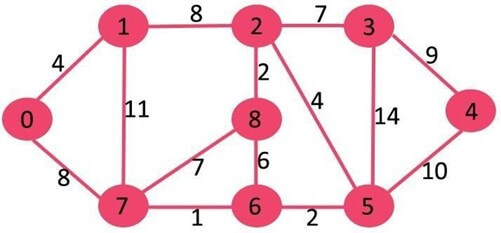
Now pick all edges one by one from sorted list of edges
- Pick edge 7-6: No cycle is formed, include

- Pick edge 8-2: No cycle is formed, include

- Pick edge 6-5: No cycle is formed, include
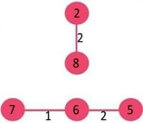
- Pick edge 0-1: No cycle is formed, include
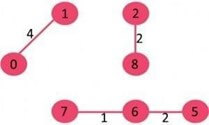
- Pick edge 2-5: No cycle is formed, include

- Pick edge 8-6: Since including this edge results in cycle, discard
- Pick edge 2-3: No cycle is formed, include

- Pick edge 7-8: Since including this edge results in cycle, discard
- Pick edge 0-7: No cycle is formed, include
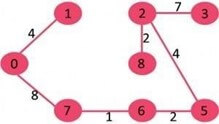
- Pick edge 1-2: Since including this edge results in cycle, discard
- Pick edge 3-4: No cycle is formed, include
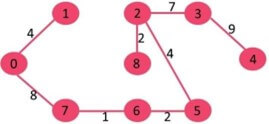
ALGORITHM
step 1: declare variable as int p,q,u,v,n;
step 2: Initialize min=99,mincost=0;
step 3: declare variable as int t[50][2],i,j;
step 4: declare variable as int parent[50],edge[50][50];
step 5: Begin
step 6: write “Enter the number of nodes” step 7: read “n”
step 8: Initialize i=0
step 9: repeat step(10-12) until i<n step10: increment i
step11: write”65+i”
step12: Initialize parent[i]=-1
step13:wite “\n”
step14: Initialize i=0
step15: repeat step(15-21) until i<n
step16: increment i
step17: write”65+i”
step18: Initialize j=0 step19: repeat until j<n step20: increment j
step21: read edge[i][j]
step22: Initialize i=0
step23: repeat step(23-43) until i<n
step24: increment i
step25: Initialize j=0 step26: repeat until j<n step27: increment j
step28: if’edge[i]j]!=99
step29: if’min>edge[i][j] repeat step (29-32) step30: intialize min=edge[i][j]
step31: intialize u=i
step32: intialize v=j
step33: calling function p=find(u);
step34: calling function q=find(v);
step35: if’P!=q repeat steps(35-39)
step36: intialize t[i][0]=u
step37: intialize t[i][1]=v
step38: initialize mincost=mincost+edge[u][v]
step39: call function sunion(p,q)
step40: else repeat steps(40-42)
step41: Intialize t[i][0]=-1;
step42: Intialize t[i][1]=-1;
step43: intialize min=99;
step44; write”Minimum cost is %d\n Minimum spanning tree is”,mincost
step45: Initialize i=0
step46: repeat until i<n
step47: increment i
step48: if’t[i][0]!=-1 && t[i][1]!=-1’repeat step(48-50)
step49: write “%c %c %d”, 65+t[i][0], 65+t[i][1], edge[t[i][0]][t[i][1]]
step50: write”\n”
step51: end
step52: called function sunion(int l,int m) repeat step(51-52)
step53: intialize parent[l]=m
step54: called function find(int l) repeat step(53-56)
step55: if parent([l]>0)
step56: initialize l=parent
step57: return l
Program:
#include<stdio.h>
int p,q,u,v,n;
int min=99,mincost=0;
int t[50][2],i,j;
int parent[50],edge[50][50];
main()
{
printf(“\n Enter the number of nodes”);
scanf(“%d”,&n);
for(i=0;i<n;i++)
{
printf(“%c\t”,65+i);
parent[i]=-1;
}
printf(“\n”);
for(i=0;i<n;i++)
{
printf(“%c”,65+i);
for(j=0;j<n;j++)
scanf(“%d”,&edge[i][j]);
}
for(i=0;i<n;i++)
{
for(j=0;j<n;j++)
if(edge[i][j]!=99)
if(min>edge[i][j])
{
min=edge[i][j]; u=i;
v=j;
}
p=find(u);
q=find(v);
if(p!=q)
{
t[i][0]=u;
t[i][1]=v;
mincost=mincost+edge[u][v];
sunion(p,q);
}
else
{
t[i][0]=-1;
t[i][1]=-1;
}
min=99;
}
printf(“Minimum cost is %d\n Minimum spanning tree is\n”
,mincost); for(i=0;i<n;i++)
if(t[i][0]!=-1 && t[i][1]!=-1)
{
printf(“%c %c %d”, 65+t[i][0], 65+t[i][1], edge[t[i][0]][t[i][1]]);
printf(“\n”);
}
}
sunion(int l,int m)
{
parent[l]=m;
}
find(int l)
{
if(parent[l]>0) l=parent[l];
return l;
}
Output:
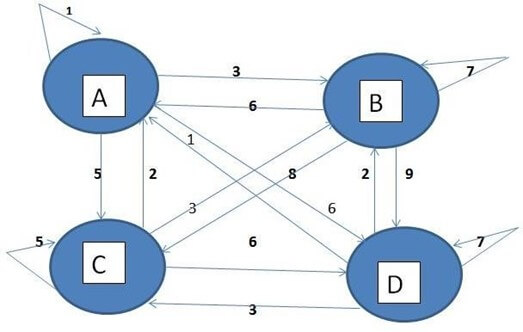 Enter the number of nodes 4
Enter the number of nodes 4
A | B | C | D | |
A | 1 | 3 | 5 | 6 |
B | 6 | 7 | 8 | 9 |
C | 2 | 3 | 5 | 6 |
D | 1 | 2 | 3 | 7 |
Minimum cost is 9 Minimum spanning tree is
B A 6
C A 2
D A 1
